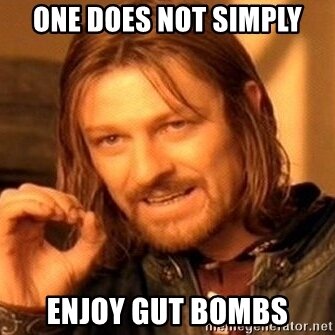Ever had a Gut Bomb during a race? Or more than one?
If you have, I feel your pain... It. Is. The. Worst.
It’s one of the reasons I got into the sports nutrition field many moons ago. I had trained so hard for a marathon in hopes of Boston-qualifying, but the Mile 18 Gut Bomb shut down those aspirations pretty quickly.
Fast forward to nowadays though… and I’d like to let ya’ll know something, especially to those who are new or getting back into endurance sport, or even to those who are endurance sport junkies:
Having gut bombs is not a rite of passage.
You don’t have to “put up with it.”
It is not part of the game.
What exactly is the Gut Bomb? (aka “gastrointestinal distress” as us industry folk like to refer to it) There are many manifestations of it:
flatulence (aka “Toot City”)
bloating (aka “I feel like I swallowed a balloon!”)
belching (aka “I hope this doesn’t lead to throwup in my mouth.”)
abdominal cramping (aka “My insides feel like they’re going to burst.”)
vomiting (I get grossed out just typing the word.)
diarrhea (aka “Hello Porta Potty Tour)
Most of us have a historical (or hysterical?) Gut Bomb story that we may find fun to share with our training pals. Like, “Oh hey, you thought you had it bad when you puked 14 times during that 100-miler, but have I got a story for you!!” type thing.
So if you’re in the camp that likes to suffer GI-wise and you don’t mind having the shits or pukes as part of your journey to the finish line, then by all means… ummm…. I guess that’s your decision completely.
But if you’re really not a fan of all that stuff and want to figure it out (or prevent it), then I have one simple tip for you to start figuring it out. It is something I rarely see athletes do but can be uber helpful in troubleshooting:
KEEP A LOG.
I know you already document your training and take a gob of selfies so I don’t mean that kind of log.
I’m talking about keeping a training nutrition and hydration log, especially for the key training sessions you do such as long bricks, long days out on the trails, and race simulation sessions.
This is such an easy thing to do and takes only a handful of minutes to document what, when, and amounts of foods and fluids you consumed (and other stuff like caffeine, electrolyte capsules, and don’t forget the extra oatmeal cookie your friend gave you at hour 4 on the bike) for those training sessions.
Additionally, note what you ate and drank the day before… cuz that stuff definitely can “hit ya” on a big training day, resulting in extra yucky GI issues.
Lastly, don’t forget to jot down how you felt throughout. This can include anything objective and subjective that wasn’t captured in your training data. How often did you pee? Poo? Did you have any cramping or bloating? What felt good and didn’t? How hot was it? Or were you at altitude? Women, what day of your menstrual cycle is it? Etc., etc.
I think you get the picture. The more data you capture, the more we can fine-tune and master your race day or competition day plan. Bring us your info and The Nutrition Mechanics will get ya dialed in.
I’m all for fewer Porta Potty visits and a lot more kickin’ assery.
-Dina


